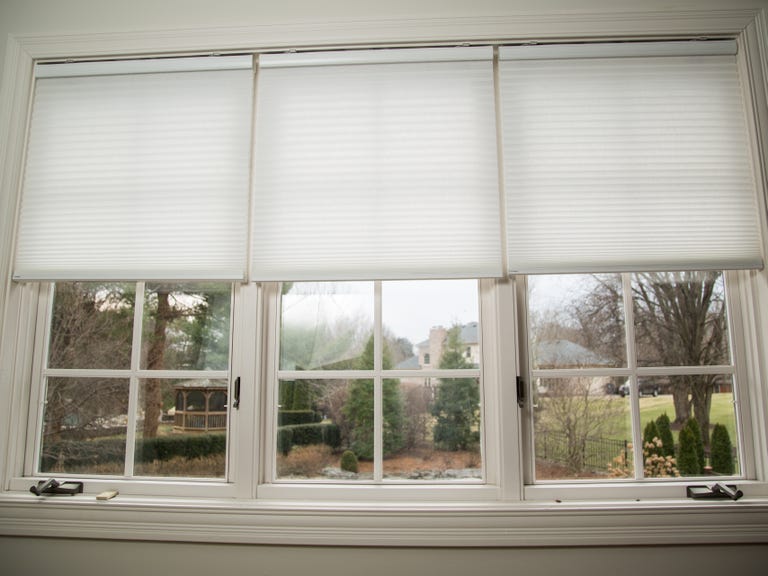 Why You Can Trust CNET
Why You Can Trust CNET Lutron Serena Remote Controlled Shades review: Lutron's Smart Shades have potential, but it comes at a high price
Lutron's Serena Shades work with HomeKit, but aren't quite worth the price tag.
Automated shades can be a cool feature for any living space, but when you start looking at the market, you might be surprised how expensive outfitting a whole home can be. That said, smart shades and blinds have a lot of potential. They can make windows in hard-to-reach places more accessible, and can be important tools for the disabled or elderly.
The Good
The Bad
The Bottom Line
Lutron's Serena Remote Controlled Shades can't solve the price problem (each unit costing around $350 at the least, plus $150 for the Caseta Bridge that integrates with Apple HomeKit). But their hefty price tag makes a little more sense than what you'll pay for other smart shades. Not only do they boast features like Siri voice control and geofencing-based automation, they also integrate with plenty of other smart home gadgets, like thermostats and lights.
Despite the pricing and a few performance hiccups, those who need smart shades for a few vaulted windows or a particular bedroom will find a helpful solution in Serena.
How do they work?
Serena Shades are pretty easy to set up. With a power drill and a couple screwdrivers, I was able to set it up within 30 minutes. Add in the 15-minute setup of the Lutron Caseta Smart Bridge, the 10 minutes for the app and the five minutes for the remote, and the whole thing can be up and running in about an hour.
The good news is, besides the Caseta Bridge, you'll only have to buy shades. No extra hubs, no extra remotes. In fact, the only reason you need the bridge is to cut down on battery usage, since Apple HomeKit -- the home integration system Serena uses -- relies on Wi-Fi, which drains batteries fast. So your mobile app communicates with the plugged-in Caseta Bridge, which in turn communicates with the Serena Shades using a low-energy communication protocol.
The Caseta Bridge connects directly to your router.
Once everything is set up, using the Lutron app to control the Shades is a breeze. You can set timed scenes, use Siri voice control, automate commands with Geofencing, and integrate with other smart home gadgets. Here's how each feature stacked up.
Scenes: These are simple to set up in the app, but too basic in their capabilities. Setting your shades to open or close at certain times is nice, and the astronomic time clock even lets you personalize your scenes based on when the sun rises and sets where you live. The problem is, these scenes can't be triggered by anything except time. So you can't set the cellular shades to close and conserve heat if the thermostat's temperature is drifting too low. The only way to use triggers like these would be through IFTTT or Elgato, compatible third-party apps.
Siri: Voice control is one of the biggest appeals to Apple HomeKit. The problem is, Siri is still incredibly finicky. I ended up having to rename my shades because she never understood and responded to "left shade" "middle shade" or "right shade." Plus, despite the name, Lutron's "Scenes" don't equal HomeKit's "Scenes." That means you can't activate scenes from the Lutron app using Siri.
Using scenes, you can schedule the shades to open or close at particular times. Disappointingly, Siri can't control these scenes.
HomeKit: Serena works with Apple HomeKit, the integration system that uses your Wi-Fi and requires no extra hubs. This partnership works well. To integrate your shades with other gadgets, you just need a router and an iPhone or iPad. Unlike Somfy Motorized Blinds, no expensive whole-home automation system like Savant (or even more affordable system like Lowe's Iris) is necessary.
Integration: Once you have the $150 Caseta Bridge -- which falls between comparable bridges from Somfy ($200) and Philips Hue ($60) -- the Lutron app will let you integrate with Lutron products, select Honeywell thermostats, the Nest Learning Thermostat, certain Logitech gadgets and compatible HomeKit products. While this list isn't the most impressive lineup of smart home devices, Serena works with more products than any other smart shades I've seen.
Geofencing: This GPS-based solution is one way developers have tried to automate smart home tech. Usually using GPS to determine whether users are home or not isn't very reliable. Surprisingly, Lutron's app tracks you effectively -- though with occasional delays -- and can operate your shades based on whether you're leaving home or coming back.
The batteries live in the body of the Serena Shade, and can last as long as four years, depending on the model and size.
Design: Lutron's Serena design is really clever. First off, you don't need anything extra to install the shades -- they work exactly like dumb shades. Second, the batteries are housed inside the body of the product, unlike others, such as Somfy Motorized Shades. Third, when you need to replace the batteries (which should last between 2 and 4 years, depending on the size and model), you can simply push the plastic tabs suspending the shade, and the body will swivel down and allow you to access the batteries without unlatching the whole thing. The motors are also quiet and smooth, and the response to commands, whether issued by remote or through the app, is consistently quick.
Conclusion
Although the price is too high for most consumers to comfortably afford multiple Serena Remote Controllable Shades, the product is pretty sharp. App control is intuitive, the interface is feature-rich, and the HomeKit integration makes the product's future promising. But until they become more affordable and some of the technical performance errors are rectified (particularly with Siri integration) I can only recommend them for particular needs, like vaulted windows or a specific room.


